Unusual Processes and Features
Abstract
Not everything of relevance to airless body processes can be easily classified into one of the previous chapters. In lieu of a series of very short chapters or introducing tangents into discussions, we collect additional topics here. These range from processes that are still mysterious to elaborations that involve concepts from multiple chapters.
Keywords
Transient lunar phenomena; Swirls; Impactor contamination; Irregular mare patches; Faculae
Introduction
Not everything of relevance to airless body processes can be easily classified into one of the previous chapters. In lieu of a series of very short chapters or introducing tangents into discussions, we collect additional topics here. These range from processes that are still mysterious to elaborations that involve concepts from multiple chapters.
More About Asteroid Families
As mentioned in Chapter 7, the impacts that create regolith on asteroids can also create dynamical families because the relatively weak gravity of the asteroids leads to escape speeds that are quite small compared to their heliocentric speeds. Laboratory experiments suggest that ejecta speeds for asteroidal impacts will be ~ 10 m/s. Using the vis-viva equation from Chapter 9 shows that ejecta with speeds of tens of meters will still have heliocentric semimajor axes within 0.01 AU of a parent body in the main asteroid belt.
The Yarkovsky force, also mentioned in Chapter 10, has an effect on the orbits of objects that is size dependent: because the effect is proportional to the surface area of an object but the mass of the object is proportional to its size cubed, the drift rate is inversely proportional to the size.
Researchers have used this relation to help map out the members of asteroid families: a plot of inverse diameter vs semimajor axis shows members of a given family to fill in a V-shape. The edges of the V are marked by those objects with spin pole position and thermal properties nearest the optimum values for maximum drift (Fig. 11.1). This envelope, along with estimates of the thermal properties of asteroids, allows an age to be calculated for the asteroid family. While appropriate samples have not been identified in the meteorite collection or retrieved by spacecraft, we might expect Ar-Ar ages (Chapter 4) from these objects to record these family formation ages.
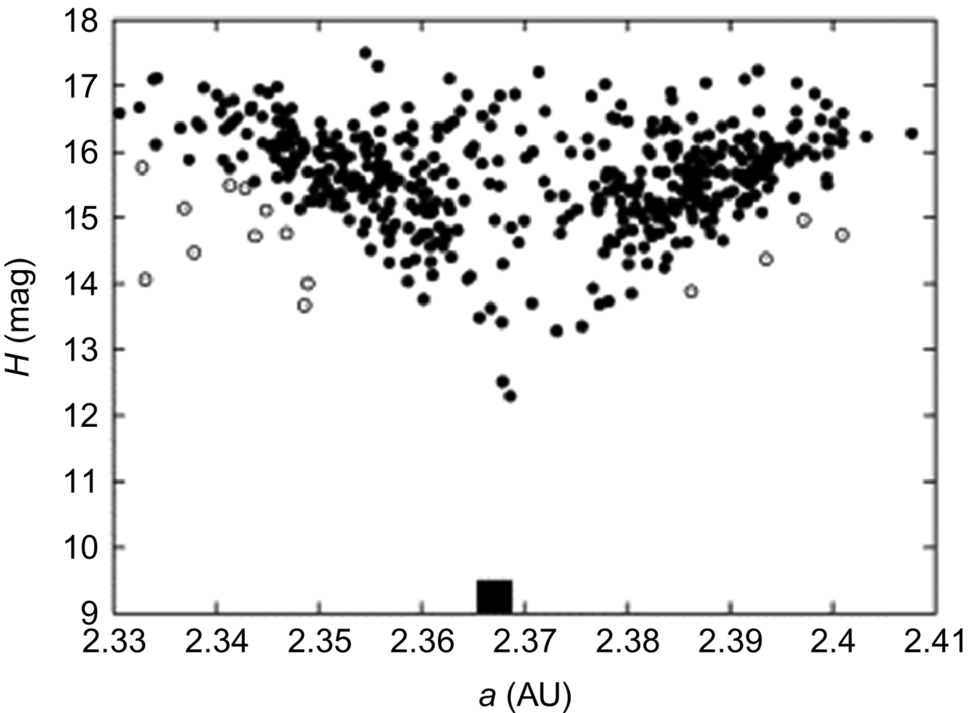
The Phobos and Deimos Dust Tori
The concept of asteroid families can be abstracted to other situations. Escape speed from the Moon is sufficiently high that ejecta moving fast enough to escape from the Moon will also be moving so fast as to be likely to escape from the Earth-Moon system entirely. However, that is not true of ejecta from Phobos and Deimos. Deimos’ average orbit speed around Mars is 1.35 km/s and Phobos’ is 2.14 km/s, both very large compared to their escape speeds (~ 5 and ~ 11 m/s, respectively) and likely ejecta speeds. As a result, a large fraction of ejecta from Phobos and Deimos likely stays in the Mars system, as mentioned in Chapter 7. As also mentioned, a large fraction of ejecta reaccretes to the satellites or Mars. Ejecta from dekameter-scale impactors takes 102–104 years to be cleared from the martian system, and the timescale between those impacts is of order 100 My. Therefore, at any given time we might expect the Mars system to be relatively free of debris from impacts onto Phobos and Deimos.
However, micrometeoroids are constantly raining down upon the martian moons. Roughly 105 particles of μm-scale or larger hit each of the satellites per second, producing a constant spray of ejecta dust. While this dust has a short lifetime due to reaccretion or radiation forces, it is generated frequently enough that scientists expect a steady-state population to be present and that dynamical forces would spread dust from Phobos and Deimos into two tori, one centered near each satellite's orbit. Dust from Phobos and Deimos could play a role in resurfacing the moons, particularly if it serves as an enhancement to the interplanetary micrometeoroid flux. However, while theorists are fairly confident that these dust tori exist, they have thus far escaped detection from Earth- or Mars-based remote and in situ measurements.
Transient Lunar Phenomena
Sudden but short-term brightening on the lunar surface has been reported sporadically for centuries. These events, collectively termed “transient lunar phenomena” (TLPs), have been the subject of great debate in the scientific community. This is because they have tended not to be observed by professional astronomers and their short duration and localized effect means that each event has typically only been seen by a single observer. Furthermore, they are sufficiently infrequent that dedicated observing programs have not been seen as worthwhile. Nevertheless, hundreds of reports of TLPs have been made, and in the 1970s they were cataloged in terms of duration and color by Cameron (1972). Today there is a general sense that at least some of the TLPs represent neither observer error or an effect from the Earth's atmosphere but an actual process occurring on the lunar surface.
The highest-confidence TLPs seem to cluster near Aristarchus, a 40-km diameter crater on an eponymous plateau in Oceanus Procellarum that is one of the most prominent features on the Moon's near side (Fig. 11.2). Interestingly, alpha-particle detectors and spectrometers on the Apollo 15, Apollo 16, Lunar Prospector, and Kaguya missions all detected an enhanced signal near Aristarchus, interpreted as due to the isotope radon-222 (Lawson et al., 2005; Kinoshita et al., 2016). The Lunar Prospector results were interpreted as showing an association between the sites of radon detections and pyroclastic deposits. These observations suggest that there may be a connection between TLPs and subsurface gas release, with the brightening possibly due to lofting of regolith and a resulting increase in surface area that can reflect sunlight. Whether such gas release is a sign of ongoing volcanic activity or of ongoing mass wasting in an area with unusually high amounts of subsurface gas is not clear.
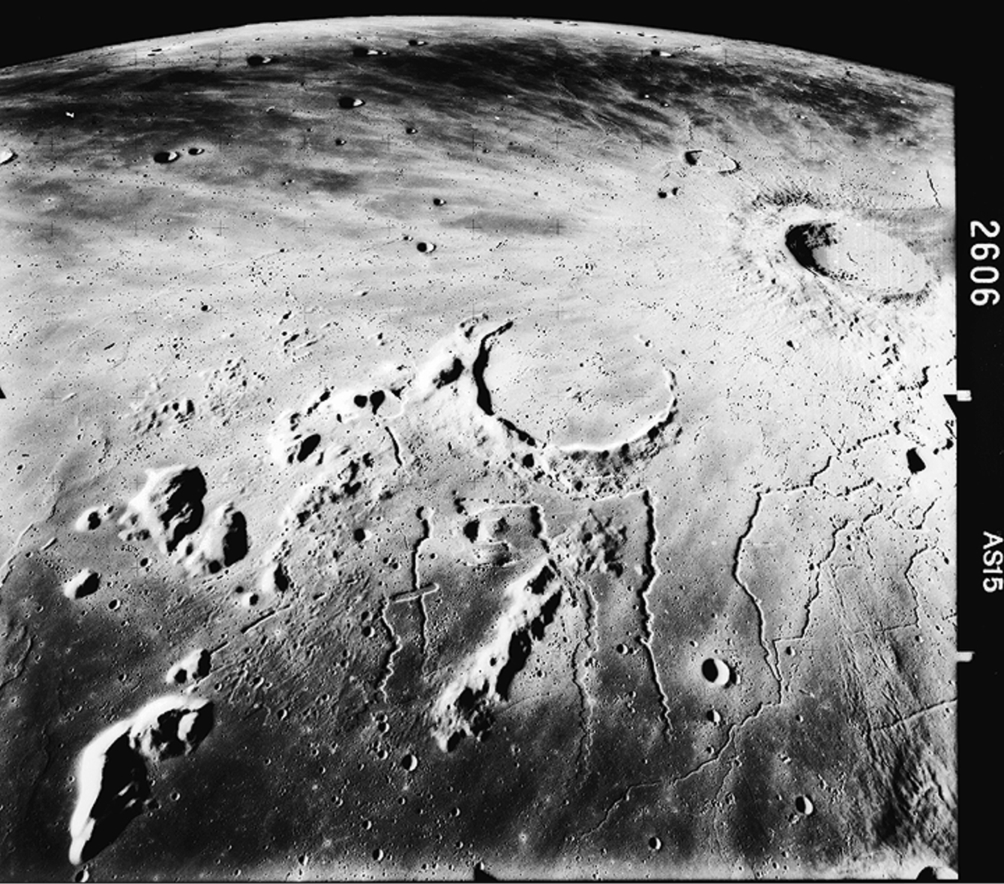
Another proposed process is charging of electrostatically lofted regolith (Chapter 8) followed by discharge, with the brightening during TLPs caused during lightning-like discharges. Impact flashes appear to be inconsistent with the observed properties of TLPs, but programs that are underway to observe impact flashes on the Moon will presumably also provide more quantitative data for any TLPs that occur during their monitoring periods. Imagery from Clementine taken of the same area before and after TLPs found no changes that could be attributed to those events (Buratti et al., 2000).
Resurfacing by Tides and Temperatures
The asteroids, by dint of their varied and varying orbits and small size, can experience very unfamiliar processes. The near-Earth asteroids in particular, because of their dynamical mobility, can have eras where some processes are important followed by eras where they are not. The evolution of NEA orbits can bring them close to the Sun and the inner planets, with consequences for their geology.
The comet Shoemaker-Levy 9 collided with Jupiter in 1994, but not before passing close enough to the planet to be torn apart by tidal forces from the giant planet. The inner planets are much less massive than Jupiter, but it is thought that mass wasting and resurfacing can be induced by close flybys. There is no strong consensus on the details, however: a look at the relative fraction of S-class and Q-class asteroids suggested that resurfacing could occur on Earth flybys of as much as 16 Earth radii, far beyond what a forward calculation using likely asteroid properties would suggest is possible, as is detailed in Chapter 8.
Disentangling effects that might be due to close planetary flybys from those that are due to YORP or other processes is the subject of ongoing research, which should be significantly aided by study of NEAs as they pass close to Earth. One eagerly awaited encounter is that of the asteroid (99942) Apophis in 2029, when it comes within 32,000 km of the Earth's surface. Observers will be hoping to determine whether this close pass is sufficient to resurface the S-class spectrum of Apophis to a Q-class spectrum.
We noted in Chapter 10 that the seasonal Yarkovsky Force will tend to shrink asteroid orbits. Encounters with planets, however, may either shrink or expand NEA orbits. As a result, a randomly chosen NEA might have spent time in an orbit with a small perihelion that was later raised.
A statistical study by Marchi et al. (2009) found that 5% of NEOs likely spent thousands to millions of years at perihelion distances < 0.2 AU. The temperatures experienced by such asteroids can be high enough to affect the composition of their surfaces: at 0.2 AU the subsolar temperature approaches 1000 K and as much as half the surface approaches 800 K. These are well above the temperatures at which minerals will become dehydrated and dehydroxylated and any organic materials will be degraded or decomposed (Delbo and Michel, 2011). It is also above the temperatures experienced by the unequilibrated ordinary chondrites, if lower than the maximum temperatures inferred for thermally metamorphosed chondrites. This effect will also potentially be seen in samples from Bennu or Ryugu returned by the OSIRIS-REx and Hayabusa 2 missions, which is part of the motivation to obtain samples from their subsurfaces, which should be somewhat insulated from surface heating.
High temperatures experienced by asteroids with low perihelia have also been implicated in mass loss. The active asteroid (3200) Phaethon is associated with the Geminid meteor shower, which is effectively an asteroid family composed of sand-sized members. Phaethon's perihelion is 0.14 AU, resulting in surface temperatures > 1000 K. Phaethon has been observed to have a comet-like tail near perihelion, but its size and temperature are inconsistent with the presence of water ice anywhere in its volume (Jewitt et al., 2013). Therefore, the meteoroids and tail are interpreted as being ejected due to thermal stresses or dessication cracking in hydrated minerals as they heat and dehydrate. As noted in the next chapter, Phaethon is the target of the proposed Japanese DESTINY + mission (Fig. 11.3).
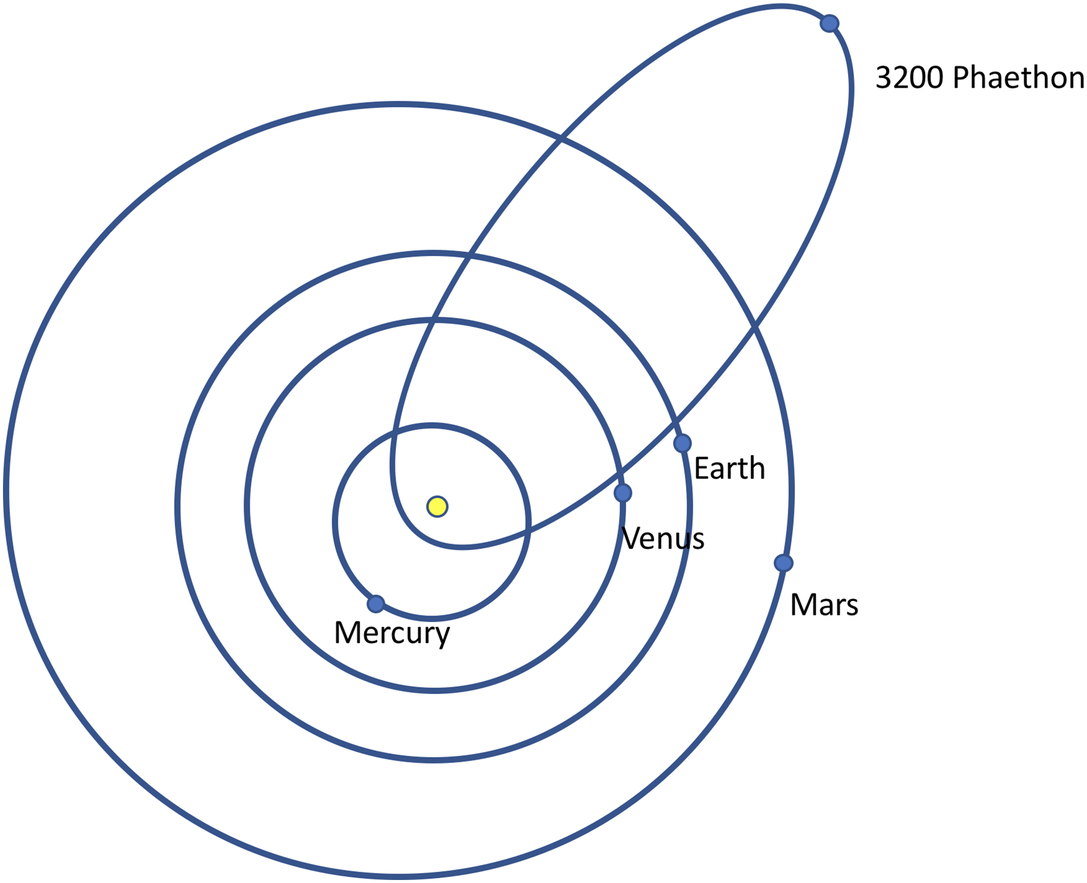
There is evidence from asteroid surveys that there are fewer low-perihelion asteroids than expected from extrapolating from the general population (Granvik et al., 2016). The deficit of low-perihelion asteroids grows stronger with decreasing size. This has been interpreted as the natural result of thermal processes like those seen on Phaethon taken to their conclusion: small objects are disrupted during low-perihelion eras and cannot survive long enough to have the opportunity to have their perihelion raised again through planetary encounters. As more NEAs are discovered, this proposed process should become better understood.
Infall at Vesta
As mentioned in Chapter 10, Dawn found evidence on Vesta of hydroxyl in minerals from their IR spectra (VIR) and hydrogen in the regolith measured by the neutron spectrometer (GRaND). The hydroxyl and hydrogen are associated with lower-albedo regions on Vesta, while higher-albedo regions, which also appear younger, have diminished or absent hydroxyl/hydrogen signatures (Fig. 11.4). A possible link was made early on between these observations and the presence of CM chondrites as xenoliths within HED meteorites. In some cases, these xenoliths can be 50% or more of the volume of the collected meteorite (Mittlefehldt et al., 2013).
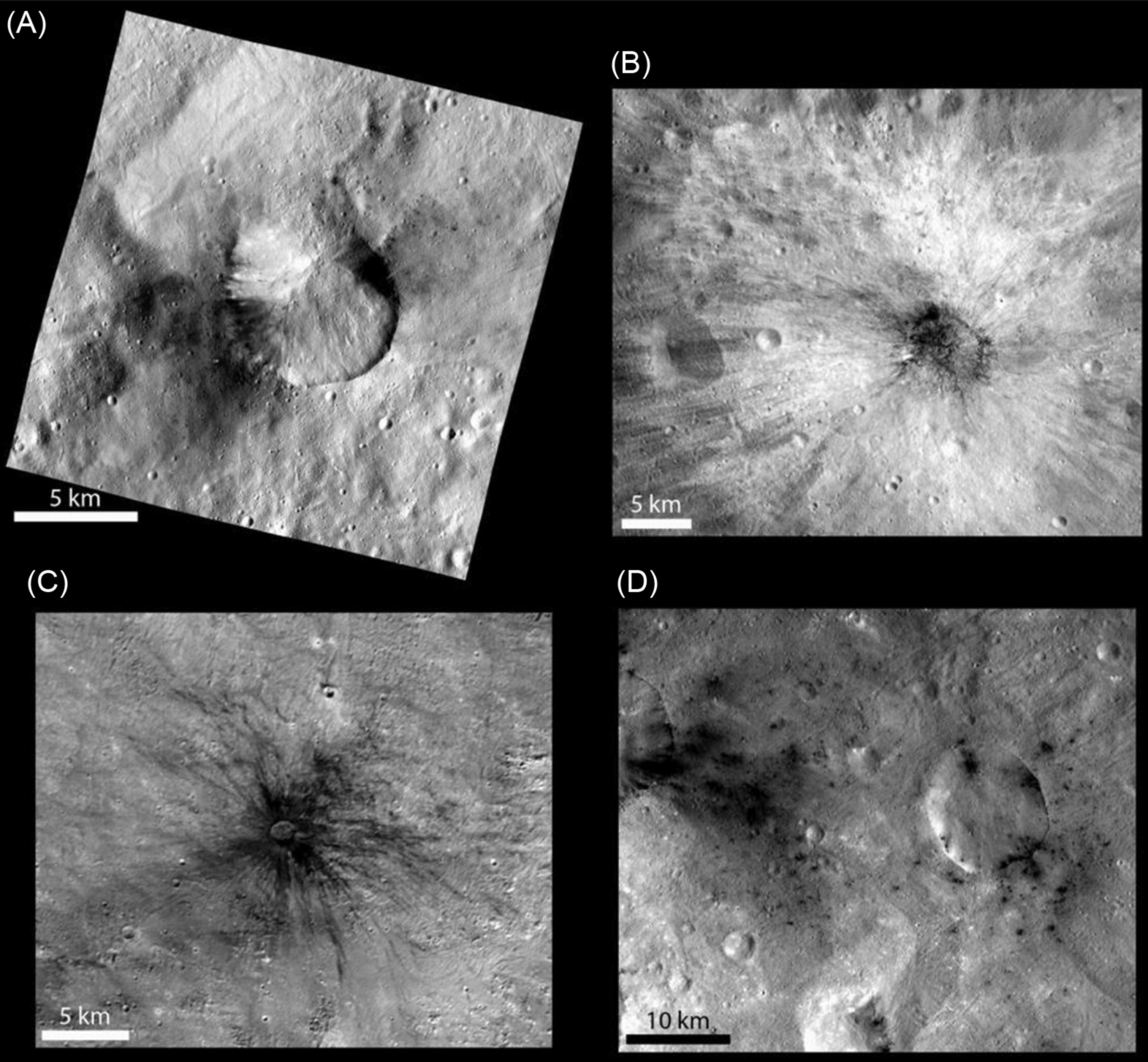
The hydrogen abundance found by GRaND is up to 400 μg/g of regolith, which is much higher than seen on the Moon by a factor of at least 3 (if not 30) according to Prettyman et al. (2012). Because the lunar regolith is thought likely to be holding as much solar wind hydrogen as it can, this is seen as evidence that the solar wind cannot be responsible for the bulk of hydrogen in Vesta's regolith, further strengthening the argument that the infall of hydrated impactors early in Vesta's history was responsible for the hydrogen and hydrated minerals in its regolith today.
Given the case for infall being important in the regolith of Vesta, it stands to reason that it may also be important for other asteroids. Unfortunately, there are very few data available for other objects. Dawn also visited Ceres and confirmed ground-based detections of pervasive hydrated minerals on its surface. Given the large amount of native hydrated minerals on Ceres, measuring an exogenic contribution in the same way it was detected on Vesta would be difficult. However, Vernazza et al. suggested that the mid-IR spectrum of Ceres showed evidence of enstatite and argued in favor of delivery via infall of enstatite-rich micrometeorites.
Irregular Mare Patches, Ahuna Mons, and Ceres’ Faculae
Large-scale endogenic activity on the airless bodies of the solar system, like the creation of the lunar maria, is thought to have long ceased. Byrne et al. estimated that the main phase of plains volcanism on Mercury had finished by 3.5 Gy ago. Even small-scale volcanism is generally thought to have finished hundreds of millions if not billions of years ago on those objects that experienced it. However, high-spatial-resolution imagery of the Moon and Dawn's visit to Ceres both have caused some reconsideration of whether these objects have experienced relatively recent (or even ongoing) activity on small scales.
On the Moon, this has arisen from the discovery of “irregular mare patches” (IMP), first in Apollo data but with many more discovered in LRO data. These are small areas, < 5 km in size, that have uneven surfaces punctuated by smooth mounds. IMP also have morphologies consistent with basaltic volcanic deposits and spectral properties more similar to fresh craters than the surrounding area. They also apparently have very young ages: taken at face value their crater count-derived ages are < 100 My, and as low as 10 My in some cases, which is a factor of 10–100 younger than the presumed end of lunar volcanism. This is consistent with their lower OMAT value, measured by Grice et al. Elder et al. summarized the formation theories for IMP as follows: caldera collapse followed by small volcanic extrusions; explosive outgassing of volatiles (perhaps related to TLPs discussed above?) exhuming an older basaltic surface; inflation of lava flows combined with mass wasting exposing fresh surfaces; recent pyroclastic eruptions; and drainage of regolith through graben caused by seismicity (from impacts or other causes) (Fig. 11.5).

Since the Elder et al. summation, an additional explanation has been suggested by Qiao et al. They interpret the Ina IMP to show features similar to a lava lake at the summit of a shield volcano, which then formed mounds of magmatic foam with porosity up to 95%. They further argue that material with such high porosity will have a significantly different crater size distribution than the surrounding area even with the same production function, estimating that accounting for this effect would change the age generated from crater counts from < 100 My to roughly 3.5 Gy, removing the need for young lunar volcanism. It is not clear if this proposed origin will hold up for further testing or for IMPs besides the Ina site, but it does seem very likely that IMPs will continue to be subject to further studies.
Recent activity has also been suggested on Ceres. Ahuna Mons is a ~ 4-km-high mountain with morphology that is interpreted by Ruesch et al. as similar to high-viscosity volcanic domes on terrestrial planets (Fig. 11.6). For Ceres, ice is thought to serve the role that rocks would fill on the terrestrial planets. Ahuna Mons is also surrounded by a geological unit that is less cratered than the surrounding area. There are multiple calibrations for transforming crater counts on Ceres into surface ages, but the ages for the units surrounding Ahuna Mons range from 70 to 210 My, which set a maximum age for the cryovolcanism that is thought to be responsible for building Ahuna Mons. It is conceivable that cryovolcanism continues to this day on Ceres.

Ahuna Mons is the best-established cryovolcanic structure on Ceres, but presumably others must have existed. A study by Sori et al. suggests that a high ice fraction (> 40%) for cryovocanic structures on Ceres would lead to their relaxation into the surrounding terrain on timescales of 100–1000 My, long enough to allow Ahuna Mons to remain easily recognizable but short enough to have allowed the existence (and subsequent destruction) of earlier generations of cryovolcanoes. Identification of older, degraded cryovolcanoes on Ceres, particularly at higher latitudes, would strengthen this hypothesis.
One notable feature of Ahuna Mons is the existence of bright streaks along its flanks. Bright regions (“facula” when singular, “faculae” in plural) occur in several places on Ceres’ surface, including on crater walls and floors. The most prominent faculae, Cerealia and Vinalia Faculae, are found on the floor of Occator Crater (Fig. 11.7) and were first detected in imagery from the Hubble Space Telescope. Stein et al. found faculae on the floors of eight craters, all of which are thought to be < 420 My old, associating these features with recent activity.
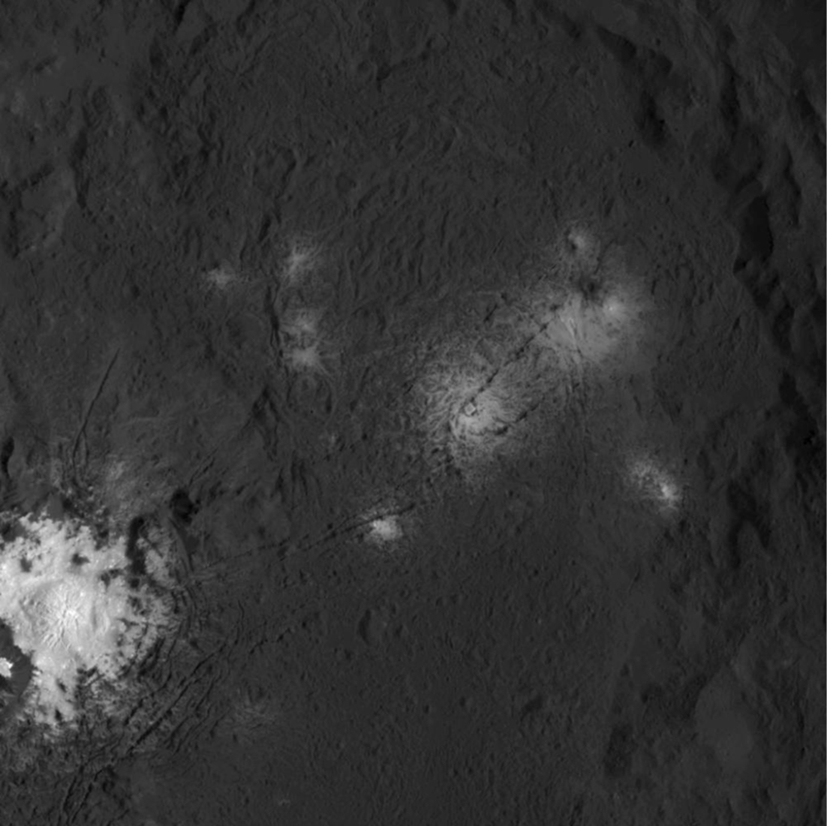
Current formation models suggest faculae on Ceres form when impacts reach volatile-rich subsurface areas, with relatively slow postimpact cooling allowing a brine to form and migrate to the surface, after which the volatiles sublime and leave high-albedo salts and carbonates behind. Alternately, impacts create cracks that allow preexisting brines to migrate to the surface. Once the faculae are created, they darken with time from exposure to space-weathering processes and mixing with background surface material, eventually fading into the background entirely. Faculae, along with Ahuna Mons, point to Ceres being an active body in the very recent past, if not today (Fig. 11.8).
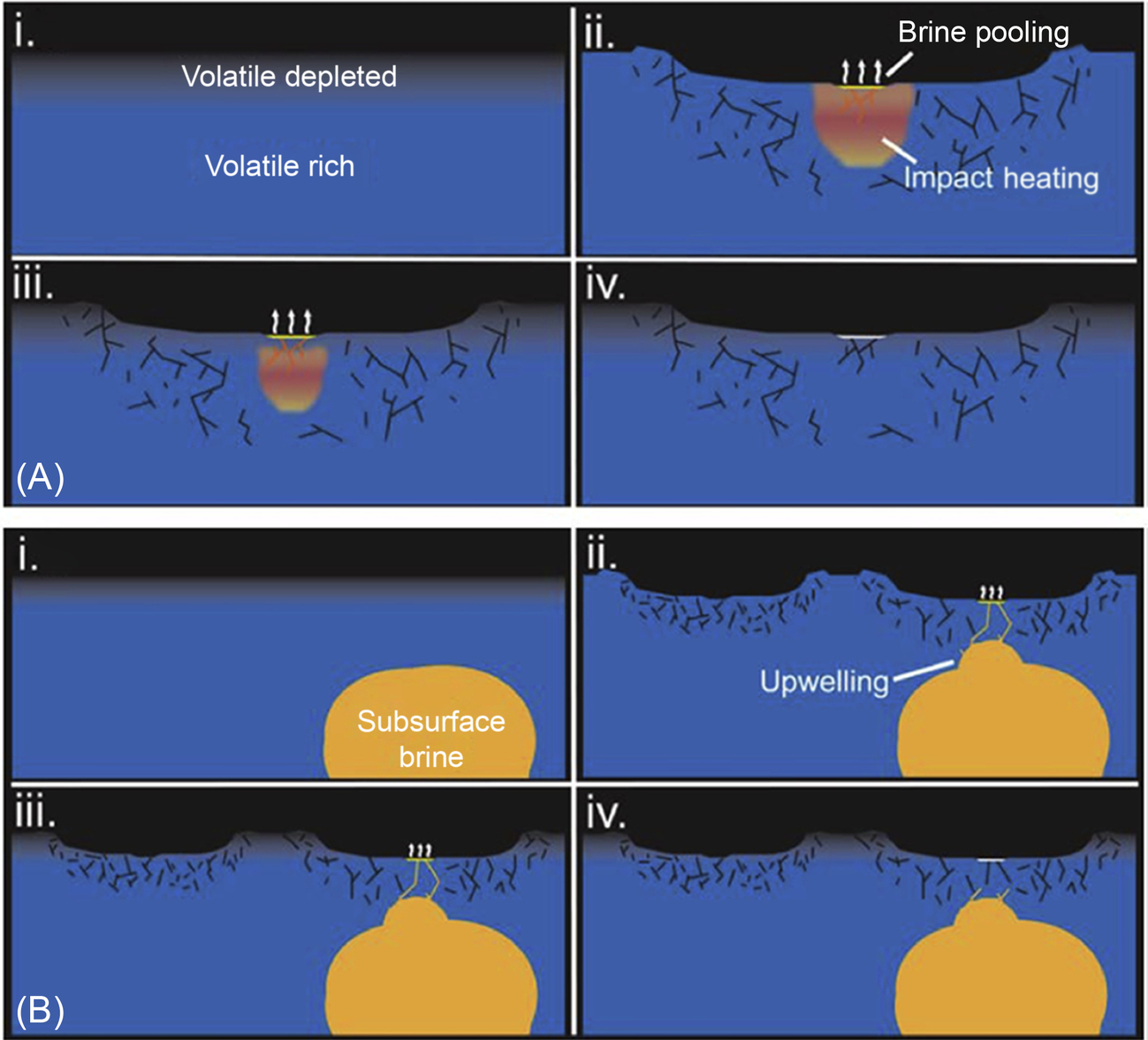
We do not have in situ imagery of large volatile-rich asteroids besides Ceres, but there are other large asteroids with visible-near IR spectra similar to Ceres like 10 Hygiea and 704 Interamnia. It is possible that these objects will also have faculae and features like Ahuna Mons, but it will likely require future flyby or rendezvous missions to determine. If these other objects also have evidence of ongoing geologic activity, we will need to completely revise our impressions of these as “dead worlds”.
Lunar Swirls
The lunar “swirls” remain some of the more enigmatic and anomalous features on the lunar surface. Swirls have puzzled investigators since they were first discovered. These features can have sharp or soft boundaries, and are not correlated with terrain or topography. They appear as curves and ribbons of high albedo, in both small patches and wide swaths. The most well-known of such features is Reiner Gamma, a tear-drop shaped high-reflectance feature, with a kite-like tail of more swirls (Fig. 11.9).
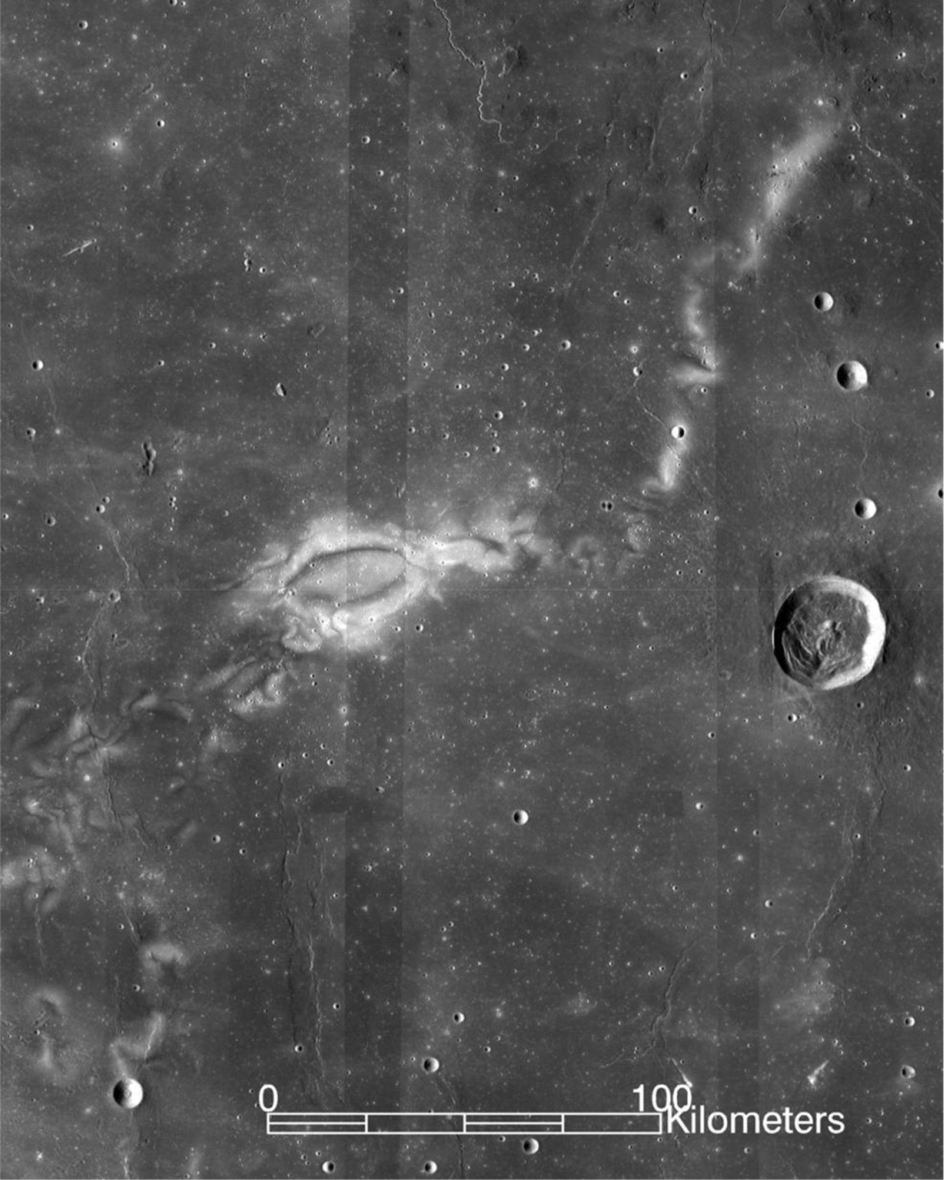
Such features have only been discovered on the Moon, which increases the uncertainty surrounding them. These features are more common in areas with higher iron abundances (that is, the maria). Lunar swirls are associated with areas of magnetized crustal rocks called magnetic anomalies (the Moon does not today have a global, internal magnetic field), yet not all magnetic anomalies have swirls. It is interesting to note that the magnetic anomalies that lack swirls are generally in areas with lower iron abundance, suggesting that both factors may be important (Fig. 11.10).

Denevi et al. (2016) mapped lunar swirls and summarized their spectral characteristics as having distinctively low 321/415 nm ratios (that is, having strong UV absorptions), while their reflectances and optical maturity (OMAT) values were less distinctive—for instance, some swirls exist with no detectable signature in OMAT images. Nevertheless, taken all together, these characteristics are seen as evidence of a more immature, or at least less space-weathered surface at swirls. The interactions of craters and preexisting swirls are also interesting: craters that appear to be similar morphologically appear to retain or lose bright ejecta blankets depending on where those blankets lie relative to swirls (Fig. 11.11), consistent with conditions on the swirls staving off soil maturity.

There are several possible hypotheses for the origin and continued persistence of lunar swirls. (1) Sorting. In this model, fine dust particles are lofted (perhaps by micrometeorite impact or by electrostatic levitation) and then sorted by existing magnetic fields. This is predicted to produce compositional differences, because the finest fraction of the lunar regolith is enriched in plagioclase. Hence, this hypothesis predicts that the bright portions of swirls would have more fresh feldspathic material (Garrick-Bethell et al., 2011). The dust-sorting model is supported by some of the work of Hendrix et al. (2) Shielding. This hypothesis suggests that the magnetic fields associated with swirls are responsible for shielding regions of the lunar surface from the solar wind. Electrically charged particles would be deflected in this case, and unable to contribute to space weathering of the surface (Hood and Schubert, 1980). This idea is supported by some of the findings of Denevi et al. (3) Comets. This model suggests that the impact of cometary gas and dust has modified the surface, producing both the high-albedo swirls and the magnetic fields that are associated with them (Schultz and Srnka, 1980).
As of this writing, it is too soon to choose between these three ideas; however, Denevi et al. favor the shielding hypothesis as best supported by the available data. This is also consistent with Blewett et al. (2010) finding that no lunar-like swirls are apparent on Mercury: given Mercury's magnetic field, the entire planet would be shielded rather than only the localized shielding hypothesized for the Moon. Further, it is predicted that comets should strike Mercury more frequently that they do the Moon; hence, it might be expected that Mercury would have more swirls than does the Moon if that hypothesis were correct. However, it is perhaps a combination of effects that are necessary for what is seen on the Moon; lofting of material through impact or electrostatic levitation with some degree of sorting that is then subsequently protected from space weathering. Further studies into these odd forms, and why they do not occur on other airless bodies, will eventually shed light on soil evolution on all rocky surfaces.
Pits and Pit Craters
At first glance, pits can be confused with impact craters, but pits on airless bodies are not formed exclusively by impact processes. While impacts have been implicated in the formation of some types of pits (see later), other endogenic conditions must be present to form certain pits. The terms “pit” and “pit crater” can be confusing, and are not yet used in a uniform fashion. Sometimes “pit crater” has been used to refer to the pit itself, and at other times the term “pit crater” is used to refer to a larger impact crater that hosts a pit or pits inside its rim.
Pits
Simple pits (sometimes called pit craters) are created when overlying material collapses into an empty or void space. They might be called “collapse craters” or “subsidence craters” depending on the specific situation. Pits can be an enigmatic type of feature, since pits can be caused by different processes. Certain pits do superficially look like impact craters, with sloping sides, circular shapes, and flat floors. But others are distinctive—some pits are mere openings into a lower empty space, and therefore have no walls (Figs. 11.12 and 11.13).

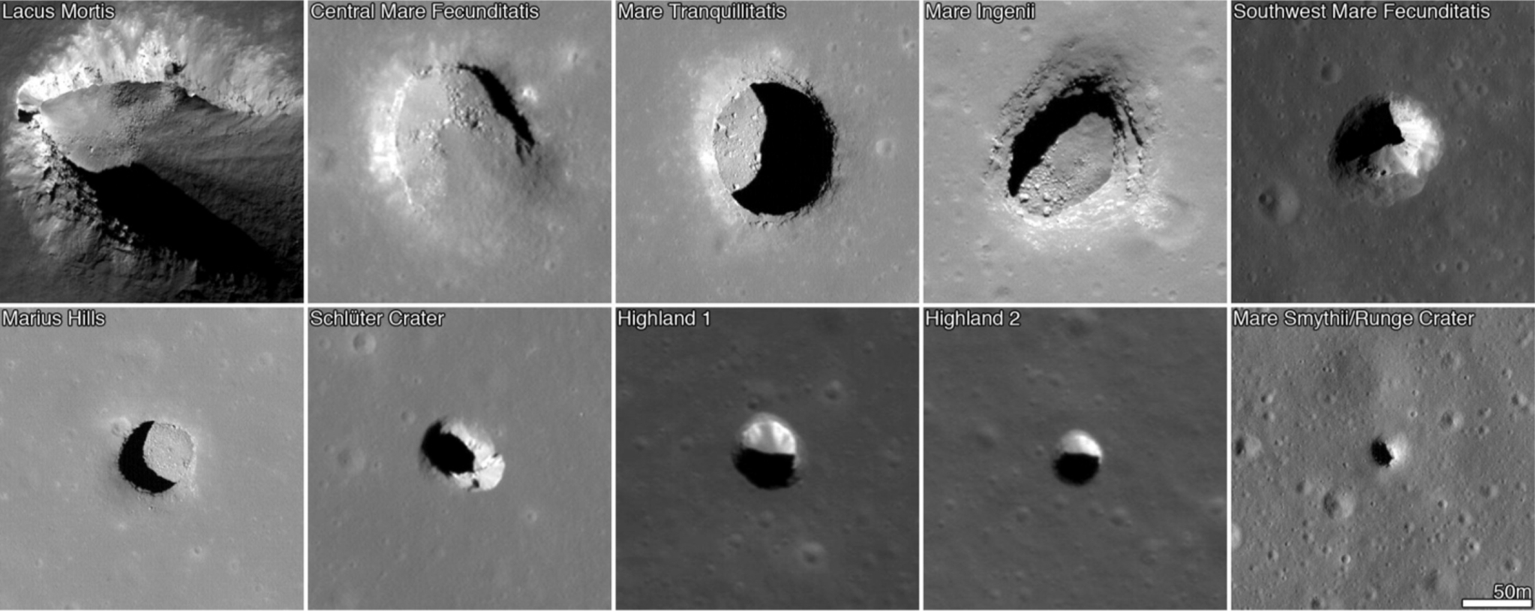
Pits have been found on the Moon, and appear to be related to volcanic melt or impact melt. On Earth, such pits can form when a void space has been left behind by the movement of magma. Subsequent to the emptying of the space, the overlying material collapses downward, either subtly, leaving sloping sides and a flat floor, or collapses completely, leaving nothing but an opening into the chamber or lava tube below. Such forms are seen on airless bodies. On the Moon, such pits are either associated with mare regions, reinforcing the relationship of these features with volcanic processes, or with the impact melt regions of craters. It has been hypothesized that the formation of a large impact crater on the Moon or Mercury (or perhaps Vesta very early in its history?) may allow for magma to flow under the surface—side slumping may force the crater floor upwards and allow magma to pool underneath. Voids would then be formed in places where magma has drained away. Wagner and Robinson (2014) conclude that lunar pits in impact melt are evidence of “extensive subsurface movement”, and also conclude that the pits formed as “secondary” features.
Pit Craters
Pit craters are those craters that possess an interior depression or depressions suspected to have been formed by endogenic processes. Gillis-Davis et al. observe two types of pit craters on Mercury. They separate the smaller pit craters from larger ones, inferring that the smaller ones are caused by volatiles explosively venting from deep magma, resulting in irregular shapes, while larger pit craters are caused by a process similar to caldera collapse on Earth, resulting in steep sides.
A specific subclass of pit craters is the “central pit craters.” Central pit craters are those that possess a specifically central depression, “either directly on the crater floor or atop a central peak or rise” (Barlow et al., 2015). These are termed “floor pits” or “summit pits,” respectively. Such pits are found in greater abundance on worlds with crustal volatiles, and have been identified on airless bodies such as the Moon and Mercury (Fig. 11.14).
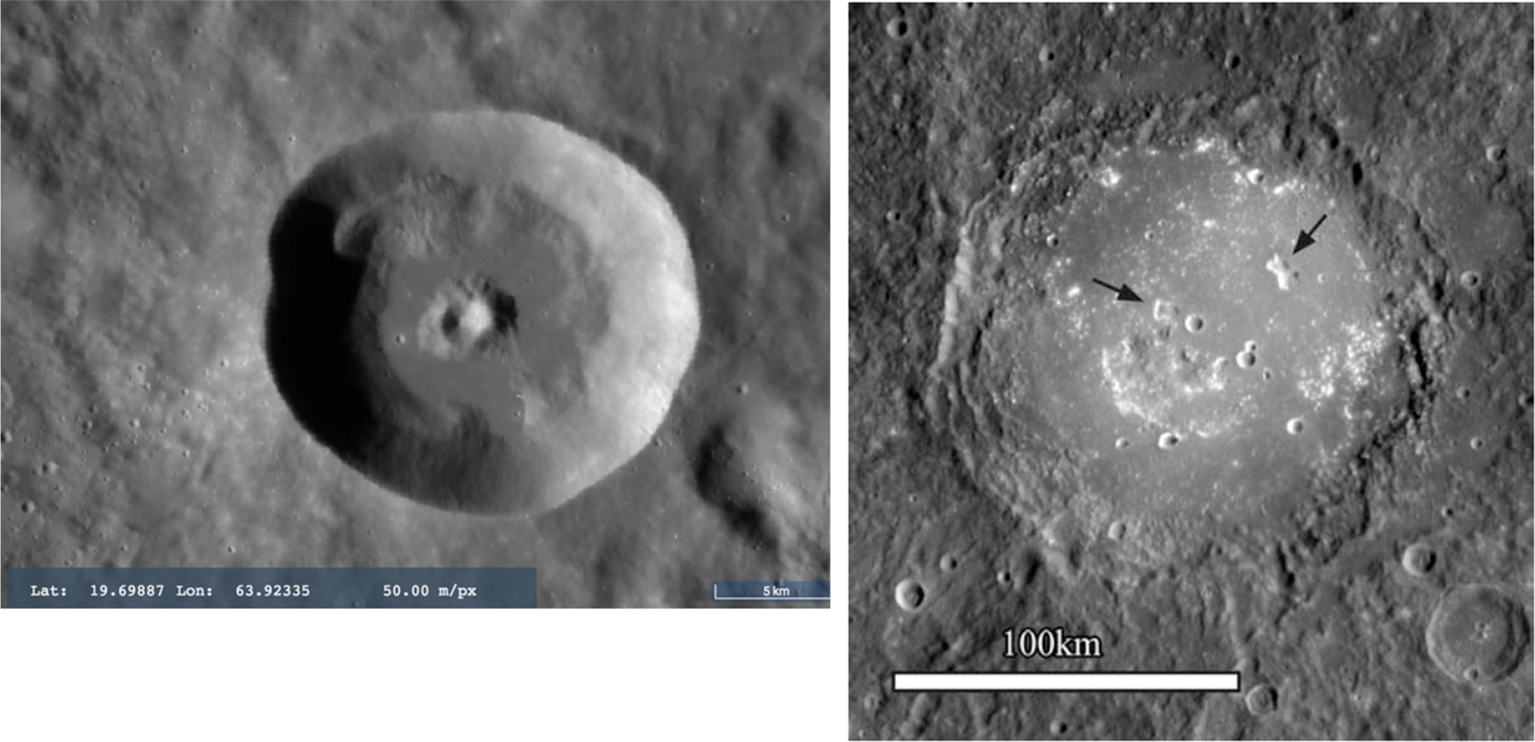
Attempts to constrain the formation mechanisms of central pit craters lend some clues into what influences their origins. Studies of relatively volatile poor worlds such as the Moon and Mercury, in comparison with those of icy outer satellites such as Ganymede, suggest some trends. Pit formation appears to happen at approximately the same time as the formation of the host crater. It may be possible that the volatiles do not cause the formation of pits on volatile-rich bodies, but that they affect the formation or expression of pits as they are created (Barlow et al., 2015, 2017).
Pit Chains
Pits can be found in chains as well as in discrete depressions. A pit chain is a linear association of pits, and may or may not be found with other features such as grooves. They may be aligned with local fault systems and fractures (Wyrick et al., 2010). Such chains have been discovered on several airless bodies, including larger bodies like the Moon, and smaller ones like Phobos, Eros, and Gaspra. Because pit chains are also found on very different worlds like Venus and Enceladus, there has been broad speculation about the possible formation mechanisms.
On the Moon, pit chains are often associated with volcanic features. Collapsed or partially collapsed lava tubes can appear as chains of pits (Wilhelms et al., 1987) (Fig. 11.15). However, this is not the only possible mechanism for pit chain formation. The pit chains of Eros were imaged by the NEAR Shoemaker spacecraft (Fig. 11.16). As noted by Wyrick et al., “pit crater chains identified on Eros are associated with areas of moderate regolith thickness.” Regolith can drain into troughs and cracks in such a way that a pit or chain of pits is formed (Melosh 2011). Chains of impact craters can also be caused by a group of fragments from a disrupted impactor, like SL-9 hitting Jupiter or the Davy crater chain on the Moon (Wichman and Wood, 1995).
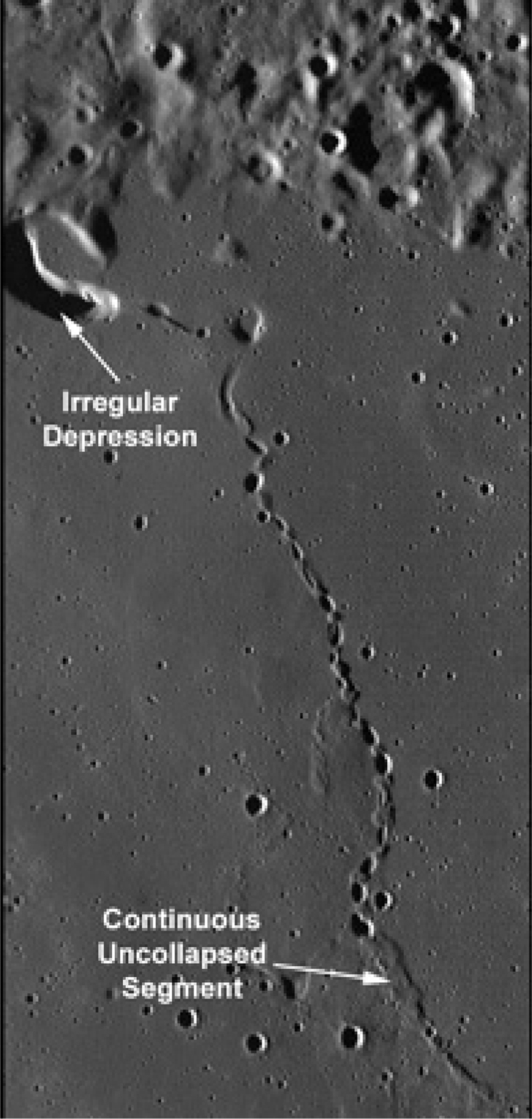

Further work is needed to understand the conditions under which pit chains can form on various worlds. Such work may lead to more insight into the nature of crustal processes on airless and other bodies.
Grooves
Phobos has two particularly striking geologic features: first is the crater Stickney, which dominates the Mars-facing hemisphere. The second is a network of long, narrow, linear structures called “grooves,” shown in Fig. 11.17. The grooves were first imaged by the Viking orbiters in the 1970s, but have defied a consensus explanation to this day. Many of the grooves appear to be associated with Stickney crater, others appear unrelated. A variety of hypotheses have been proposed for their origin, some of which are in disfavor or seem particularly unlikely, and their absence from Deimos (Thomas, 1979) appears to put constraints on some possibilities. An early suggestion was that they represented areas where degassing of water from the interior occurred, but this is at odds with our current understanding of Phobos’ composition and thermal state. It has also been proposed that they could have formed from impact of martian ejecta, but their ubiquity and geometric arguments make such an origin unlikely (Wilson and Head, 2015). A direct connection between Stickney and the grooves, with the latter representing fractures created by the former, also appears inconsistent with computer simulations of the impact that created Stickney (Bruck Syal et al., 2016).
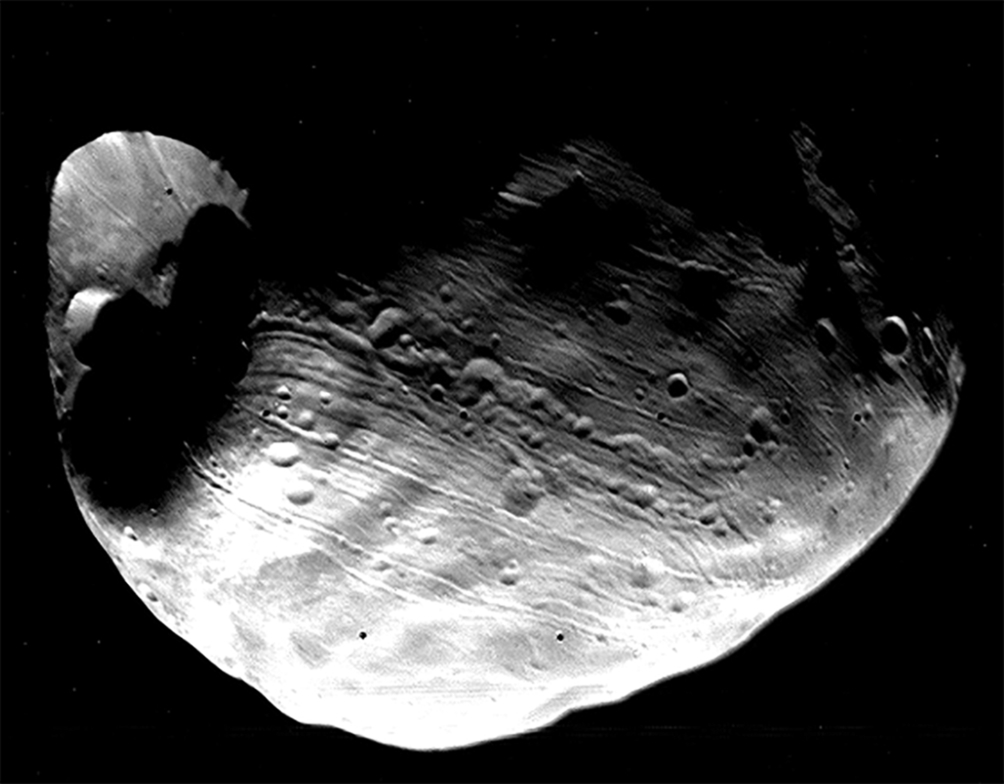
At this point, there appear to be three main classes of theory for the formation of Phobos’ grooves: reaccretion of Phobos ejecta, rolling and sliding of low-speed Stickney ejecta, and tidal stresses upon Phobos, with recent publications supporting each of these options. Nayak and Asphaug (2016) calculate that in its current orbit, Phobos reaccretes its own impact ejecta in less than three orbit periods on average—< 24 h. The vast difference in escape speed from Phobos vs orbit speed around Mars (Chapter 9) means that the ejecta does not have time to disperse before reaccretion, and cannot reaccumulate into larger masses because they are within the Roche limit of Mars. Therefore, the ejecta reaccumulates in a fashion reminiscent of a ray draped across the lunar surface. This suggested groove formation mechanism suggests that they all formed in or near Phobos’ current orbit, and that it may be possible to connect sets of grooves with their “parent” crater (Nayak and Asphaug, 2016).
The second class of theory arises from simulations of the Stickney impact. While, as noted, the fracture and damage patterns from the Stickney impact are not good matches to the locations of the grooves on Phobos, it does appear that blocks ejected at low speed from Stickney could create some of the grooves as they “slide, roll, and/or bounce” along the surface (Wilson and Head, 2015) similar to rocks seen on the lunar surface (Fig. 11.18). Wilson and Head also noted that the shape of Phobos leads to varying surface gravity and escape speeds across its surface and proposed that some blocks could, after creating grooves on part of the surface with higher gravity, escape from Phobos when reaching an area with lower escape speed.
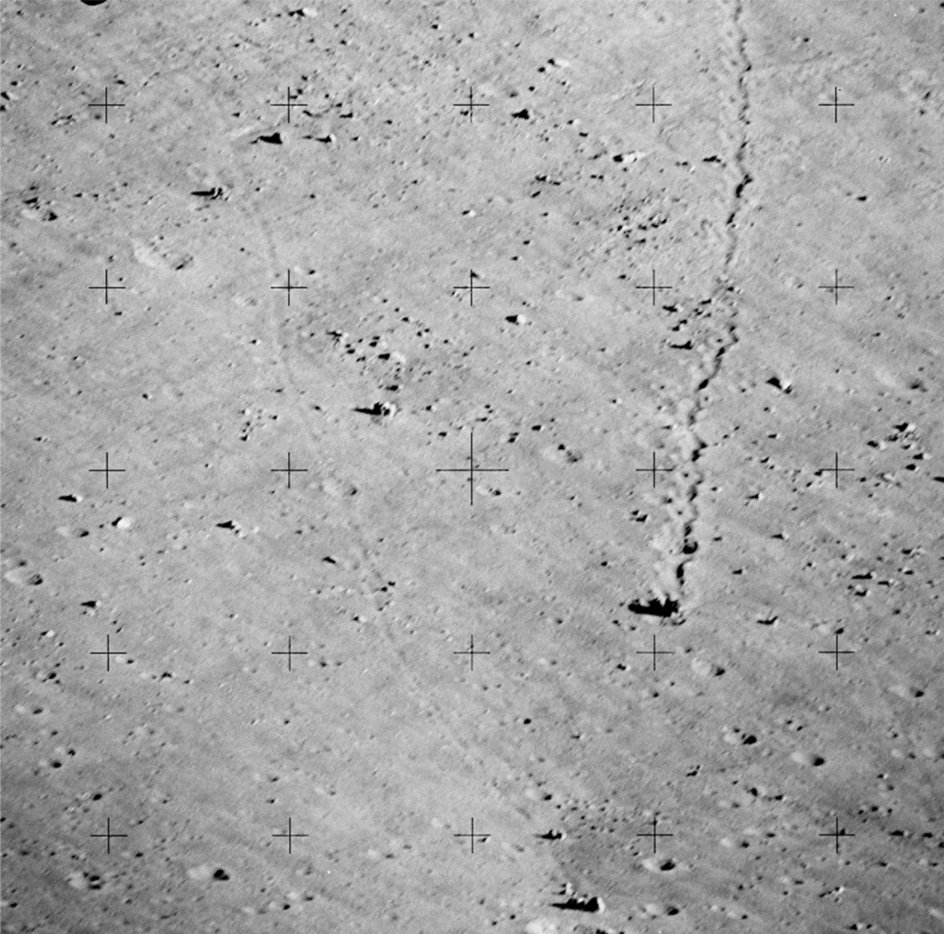
Finally, Hurford et al. (2016) investigated whether stresses induced by Mars’ tides on Phobos as its orbit decays could be responsible for the grooves. They calculate that the orientation of the stress field on Phobos is well correlated with the locations of prominent grooves, and they find that this stress field implies a weak interior overlain with a regolith of ~ 10–100 m depth.
While there are no grooves on Deimos, they can be found on some other small bodies in limited areas. The most prominent grooves on an object other than Phobos are a set of near-equatorial features on Vesta (Fig. 11.19). Individual troughs in the set vary from 19 to 380 km in length, with widths up to 15 km (Jaumann et al., 2012). Unlike the Phobos grooves, the Vesta grooves appear to be related to the two prominent basins found near Vesta's south pole: Rheasilvia and Veneneia. Stickle et al. (2015) showed that the groove and trough formation were consistent with shear deformation during the basin impacts.
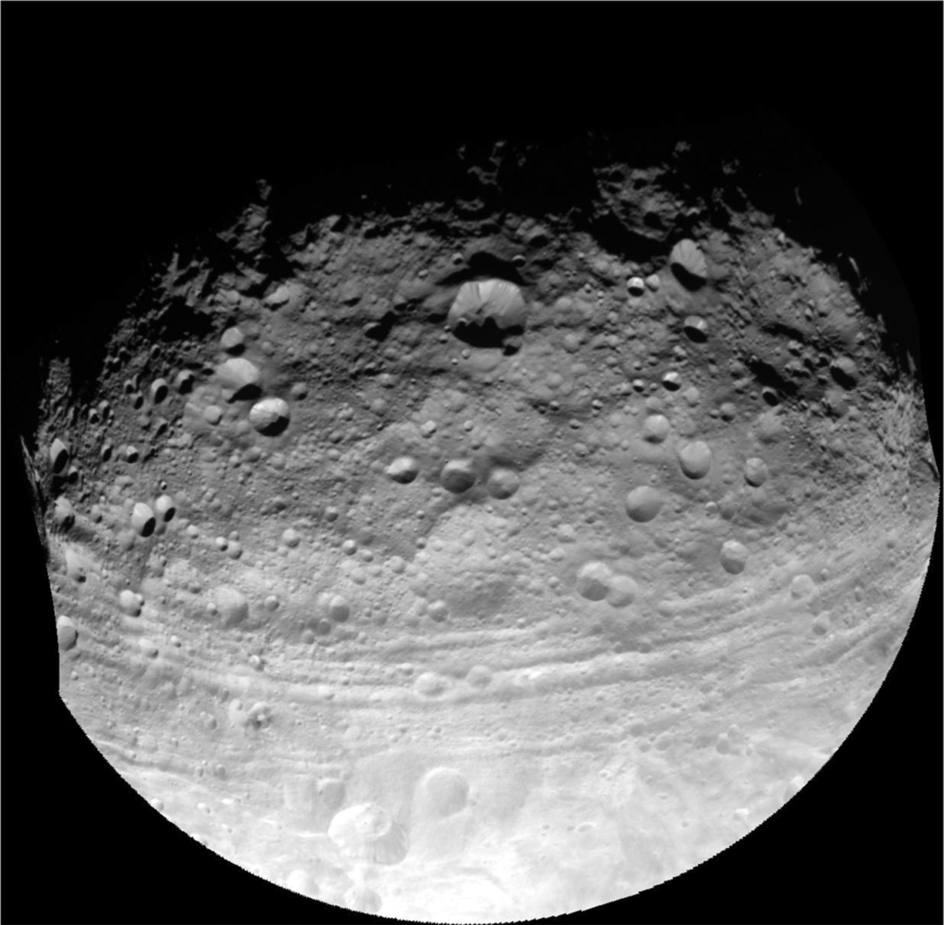
Returning to Phobos, it seems most likely that its grooves are due to a combination of several factors, both processes that occur on all airless bodies like impact fracturing and low-speed ejecta trails, and processes unique to Phobos like ejecta reaccumulation and tidal stresses.
Summary
Not every geological feature on airless, rocky surfaces is easily explainable by a single process: some have multiple possible explanations, and some may be heavily influenced by specific circumstances. Phobos and Deimos are heavily affected by the fact they are small bodies orbiting Mars, which is predicted to create dust belts along their orbits, the return of ejecta that would otherwise escape, and potentially grooves and troughs on Phobos’ surface. The most massive objects in the asteroid belt, Ceres and Vesta, have their own unusual surface features, including a possible cryovolcano on the former object and evidence of impactor contamination in the regolith of the latter. Whether these features are unique to Ceres and Vesta or are common on large asteroid surfaces awaits further spacecraft visits. The larger rocky airless bodies also feature unusual landforms. The Moon, the best-explored object discussed here, has several poorly understood areas, including the still-unexplained swirls and lunar transient phenomena. We can expect new research on all of these topics to be conducted in future years.